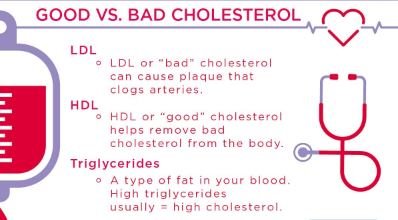What is difference between good and bad cholesterol?
difference between good and bad cholesterol is that Not all cholesterol is bad for the body. There are two types of HDL (high-density lipoprotein or good cholesterol) and LDL (low-density lipoprotein or bad cholesterol) cholesterol. While LDL causes blockage in the arteries, HDL triglycerides help transport the liver for excretion.
Good cholesterol (high-density lipoprotein or HDL) is one of the groups of lipoproteins (fat-like substances) present in the blood. HDL helps transport cholesterol and triglycerides in the liver for excretion or reuse. Therefore, good cholesterol prevents cardiovascular disease by preventing artery blockage.
Bad cholesterol (or LDL, low-density lipoprotein) is also a type of lipid present in the blood and if present in large quantities can cause health problems, as it tends to accumulate in the arteries and cause blockages. In fact, not all LDLs are the cause of atherosclerosis. There are two types of LDL cholesterol: small and dense LDL LDL and high buoyancy. It is the small and dense LDL that is more atherogenic. Small and dense LDL enters the walls of blood vessels. When LDL oxidizes, plaque builds up in arterial walls, causing blockage of blood vessels.
structure and function
Lipoproteins are a complex of apolipoproteins and phospholipids. Good cholesterol is the smallest of all lipid molecules, which are high-density molecules due to their high protein content. The function of good cholesterol is the transport of cholesterol from arteries and tissues to the liver and other organs such as the ovaries, adrenal glands, and testicles. The cholesterol delivered to the liver is excreted in the bile, and then the intestines. The cholesterol transported to the other organs is used for the synthesis of steroid hormones. The other functions of HDL include its role in the inhibition of oxidation, inflammation, activation of the endothelium and coagulation.
An LDL molecule consists of a single Apo lipoprotein molecule that circulates fatty acids. The main function of LDL is to transport cholesterol to tissues and arteries.
Effects of high cholesterol
The higher the level of LDL cholesterol in the blood, the greater the likelihood of suffering from coronary heart disease. The higher the level of HDL cholesterol in the blood, the lower your chance is of getting heart disease. Coronary heart disease is a condition in which plaque builds up within the coronary arteries. This limits the flow of oxygen-rich blood to the heart muscle.
Over time, a plate surface may break (break). This causes a blood clot to form on the surface of the plaque. If the clot becomes large enough, it can mostly or completely block the flow of blood through a coronary artery. If the flow of oxygen-rich blood to the heart muscle is reduced or blocked, angina pectoris or a heart attack may occur.
Recommended Interval
The recommended levels of HDL cholesterol are 1.55mmol / L and above. In the case of LDL, 2.6 mmol / L or less is considered optimal for the body. The recommended ranges for HDL, LDL, and triglycerides in the human body.
Foods that contain good and bad cholesterol
Foods rich in (HDL) include onions and omega-3 fatty acids such as flaxseed oil, canola oil, fish, high-fiber foods such as cereals, oats, bran, and soy. To lower LDL, avoid high cholesterol foods that are rich in trans fatty acids, refined carbohydrates such as sugar and white flour, foods, such as egg yolk, liver, kidney; Dairy products such as cream cheese, and alcohol.
You May Also Like:
- Parts of the Nervous System
- Diseases of Central nervous system
- Peripheral Nervous System: Functions and Parts
- Parts of the brain and their functions
- Parts of Central Nervous System
